Temporary Anchorage Devices: What Are They?
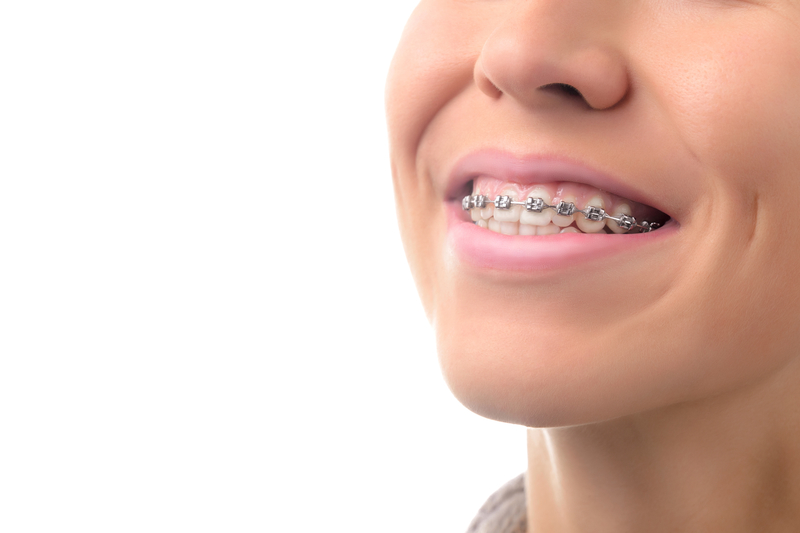
Whenever our teeth need an extra push to shift them into a straighter position, orthodontists will typically install a temporary anchorage device, commonly known as a “TAD.” Although they’re not used in every case, they help pull, push, and lift difficult to adjust teeth into the correct position. If your orthodontist recommends that you have a TAD, read through this guide to understand how they function and what you can do to maintain them!
Origins of Orthodontia
Poorly aligned jaws and teeth have been a nuisance to mankind since the beginning of time, so it’s no surprise that orthodontics has been around for so long. Archaeologists have found human remains with crooked teeth dating back 50,000 years; interestingly enough, the remains of some ancient civilizations, like Egypt, have been found with crude metal bands around their teeth, a form of orthodontics very similar to braces that we see nowadays. The ancient Greek, the Etruscans, and the Romans also practiced orthodontia and kept records of their discoveries. The ancient Greek physician, Hippocrates, was the first to describe teeth irregularities around 400 BC, and centuries later, Celcus would advise bringing newly emerging teeth into their proper position by pushing them with your fingers.
By the 1700 and 1800s, orthodontics was developing rapidly. Pierre Fauchard, the “Father of Dentistry,” would create the bandeau that allowed teeth to align correctly by using a strip of metal with regularly spaced holes that fit around the teeth. During the 20th century, Edward Hartley Angle would identify the true properties of a malocclusion, or misalignment, and begin addressing them with an effective set of orthodontic appliances that were developed much earlier. By the 1970s, braces would further advance through the invention of dental adhesives that would allow orthodontists to stick brackets to teeth surfaces rather than wiring them around each tooth. Stainless steel replaced gold and silver that were previously used as the wire, which helped reduce the cost of braces significantly. Even with the impressive advances that we have made since the beginning of orthodontics, patients around the world still suffer from advanced teeth and jaw malocclusion that normal braces can’t resolve on their own. For the purpose of increasing the effectiveness of braces, other orthodontic devices have been invented to facilitate this process.
Orthodontic Devices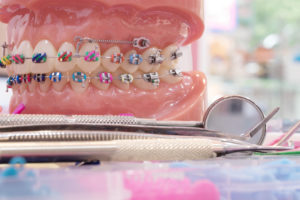
Whenever we think of “orthodontics,” we innately assume braces. Braces have two basic parts: brackets and wires. Wires move the teeth and brackets serve as a stationary holder for the wires. Contemporary braces can be stainless steel, gold-colored, or tooth-colored ceramic. Most braces go on the front of the teeth, but there are some, called lingual braces, that are fastened onto the backs of teeth that are virtually invisible. Lingual braces are not the same as clear aligners, which is another orthodontic device. Clear aligners are made of a transparent plastic-like material and are considered “invisible braces.” They are made to fit the patient’s teeth at different stages of treatment. Each set of aligners is worn for 1-3 weeks for at least 22 hours a day, and are designed to move the teeth incrementally until the next set is used. While these types of braces are a very common sight to see in many homes, schools, and workplaces, they aren’t the only devices used to move teeth and align jaws. Power chains are sometimes used with braces for an added push. They are stronger than the traditional elastic rings and can apply an extra force when needed. The last orthodontic device that is commonly used, although many patients don’t know what their purpose is, is a temporary anchorage device, or TAD.
TADs
Temporary anchorage devices, most commonly known as TADs, are used in some orthodontic cases to help shift the teeth into a straighter position when traditional braces can’t do it on their own. For this reason, not everyone needs them. TADS use titanium mini-screws (sometimes called mini-implants or micro-implants) that provide a fixed object that can be used to push, pull, lift, or intrude teeth that are being straightened. TADS don’t move and can be placed in many different parts of the mouth, so they are highly efficient at moving difficult teeth back into proper alignment. Before TADs are ever inserted into your mouth, though, your orthodontist will evaluate your teeth and determine whether your malocclusion is severe enough to receive a TAD. Before insertion, your gum tissue and jaw area will be numbed so that the procedure will be nearly painless. The TAD is then placed into your jawbone, and will eventually be removed once your orthodontist feels that it is no longer needed for straightening your teeth.
Just like braces, it may take a couple of days for the discomfort to subside and your mouth to get used to the TAD. Try taking an over-the-counter pain relief medication to alleviate any excessive discomfort. An important part of maintaining your TAD is continuing your oral hygiene regimen. Continue to brush your teeth at least twice a day and use mouthwash with antimicrobial ingredients. As long as your gums are healthy throughout the duration of your treatment, you shouldn’t have any complications with your TAD.
Get Straighter Teeth Today
To learn more about TADS, or to schedule an appointment to begin your treatment plan for braces, call Belmar Orthodontics at (303) 225-9016! At Belmar Orthodontics, we have a highly skilled and experienced team that is happy to help you start your journey to a healthier and happier smile.
Dental Emergencies With Braces

Braces are incredible devices that can help transform your teeth and reshape your jaws. However, they are not always fool-proof. Every so often, a patient will have a dental emergency. That may be a bad cavity that needs to be fixed, or a bracket or wire will break. There are only a few dental emergencies that can happen with braces. We can help you to know what to do when each of those emergencies happen!
Origins of Braces
Orthodontic treatments have been around for a long time-even as far back as the ancient Egyptians! Although their ways were archaic, people for centuries have been trying to fix crooked teeth and develop a prettier smile through orthodontic work. The ancient Greeks, Romans, and Etruscans were known to have practiced orthodontia, and interestingly, the Etruscans used to attach gold bands to women’s teeth to preserve the position of their teeth after death. Orthodontics saw a surge in progress during the 18th century thanks to Pierre Fauchard. Known as the “Father of Dentistry,” he invented an appliance called a bandeau, which was a horseshoe-shaped piece of metal with regularly spaced holes that fit around the teeth to correct the alignment. He would also use forceps to physically realign teeth into their correct positions and tie them to neighboring teeth until they healed.
Orthodontics in the United States exploded during the 19th century. J.S. Gunnell created a type of headgear that fashioned to the head and exerted a soft pull on teeth while Charles Goodyear invented vulcanized rubber which would eventually become one of the most commonly used appliances in orthodontics. But Edward Hartley Angle, the “Father of Modern Orthodontics,” took orthodontics to another level by identifying the true properties of malocclusion, or misalignment, and addressed them with his own set of orthodontic appliances in 1880. Until the 1970s, orthodontist would attach anchored brackets around each tooth with winding wires, but with the invention of dental adhesives, orthodontists could then stick the brackets to teeth surfaces. Stainless steel then replaced gold and silver as the most popular option for wires, due to its manipulability, and became the most cost-efficient option for braces.
Dental Emergencies and What To Do About Them
Braces have come a long way since their beginnings many centuries ago, but as braces have evolved, so have the problems that come with them. Although dental emergencies are few and far between when it comes to braces, there are some common issues that can be readily addressed and fixed if serious enough. The least serious issues that you can have with your braces is tooth tenderness and lip and cheek sores. As your teeth become accustomed to your braces, your teeth will most likely be sore for 2-4 days. Using headgear, rubber bands, and springs can add to this soreness, but that discomfort normally goes away in the same amount of time. Eating soft foods and taking an over the counter pain reliever can help dull the ache. Loose or broke bands and brackets are also another annoyance that sometimes occur with braces. Although not considered an emergency, they normally break due to patient’s eating prohibited foods or picking at their braces. Whenever this occurs, place a piece of wax on the spot of irritation and wait until your next orthodontic appointment, unless the broken bracket breaks on one of the upper or lower front four teeth, then call your orthodontist as soon as possible.
Protruding wires are not only bothersome, but can stab the inside of your lips and mouth if not fixed. Wires can come loose from eating sticky foods, like candy, or by picking at your braces. If this has occurred, try using a Q-tip or pencil eraser to push the wire in towards the teeth. To avoid accidental damage to the wire, make sure to not bite your nails or pens and pencils. In rare occasions, a piece of the appliance may break and be swallowed by the patient. Although alarming, keep calm and have someone look in your mouth to see if the appliance if visible. If confident that you can remove it, you may carefully attempt to do so. If you are unable to see the piece, are coughing excessively, or having difficulty breathing, that could be a sign that the piece could have been aspirated and you should contact your orthodontist immediately.
How To Protect Your Braces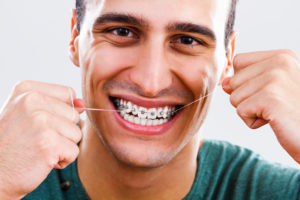
Unless under extenuating circumstances, most dental emergencies are avoidable. Maintaining good oral health and hygiene throughout your time with braces is vital in ensuring healthy teeth and gums, and preventing cavities. Food particles are easier to get stuck between braces, and when not cleaned thoroughly, can lead to other dental emergencies, like tooth decay, which can cause major complications. Hard foods, sticky foods, and foods high in sugar should be avoided as they are known to break brackets and cause cavities, which you more susceptible of developing while wearing braces. Some of the need-to-avoid foods include hard candy, nuts, apples, popcorn, ice, gum, caramel, and licorice.
Because braces are so notorious for getting food stuck in them, make sure that you are brushing after every meal to prevent staining and reducing bacteria buildup in your mouth. Use a soft brush, and brush each tooth by starting at the top and brushing down, then repeating the motion and brushing up around each bracket. Use threadable floss of a floss threader to get the hard to reach areas in between teeth that are covered by the archwire. Using the pointed end, insert between the teeth and gently move the floss back and forth between the two teeth. For added care, use a proxabrush, sometimes called a “Christmas tree brush,” to scrub between each bracket in an up and down motion to get any extra gunk that might be stuck there. For any dental emergencies that you might be having, make sure to contact Belmar Orthodontics at (303) 225-9016 for your next consultation!
Braces With Oral Health Problems
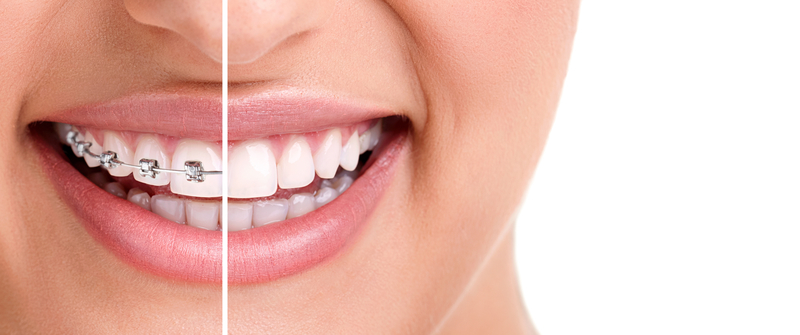
Did you know that your oral health can affect your overall health? Poor oral health can even worsen health conditions you already have such as diabetes or cardiovascular disease. That is because oral health and overall health are highly connected. Your oral issues can become better with braces, but that is only if certain oral health problems are corrected beforehand. Patients can also develop oral health problems if they don’t have the right knowledge with proper braces care. Use these tips to avoid oral health problems with braces and find out how we work around current problems to provide you with a straighter smile!
Oral Health Goals
Did you know that orthodontic treatment can give you a healthier mouth? We know that braces help straighten your teeth, but they can also improve the health of your gums and teeth. When you have crooked and crowded teeth, this makes cleaning your mouth more difficult. This can cause serious oral health problems, such as tooth decay, periodontal disease, and tooth loss. Whether you have straight or crooked teeth, before you let an orthodontist start working on you, there are some important oral health tips to be following before any work begins:
- Eat a healthy diet that limits sugary beverages and snacks
- See a dentist regularly for prevention and treatment of oral disease
- Brush teeth twice a day with fluoride toothpaste
- Floss daily
- Discuss changing certain lifestyle practices, like smoking and using oral piercings
Types of Braces
Braces are a big commitment, and you want to make sure you’re using the correct ones whenever you get them put on. Each of us is a different size and shape, and are mouths aren’t any different. Because of this, there are various types of braces for different sizes and shapes of mouths for children, teenagers, and adults. The four most common types of braces are: traditional, short-term, clear, and Invisalign/ClearCorrect.
Traditional braces are those that we see on a daily basis: a system of wires and brackets that are bonded to our teeth. This type of braces are the most cost-effective, reliable, and are best suited for severe orthodontic issues. Short-term braces are recommended for those patients who wish to align just their front six teeth-the ones that others see the most. These are used for the shortest amount of time (less teeth to align), but there is no adjustment to your occlusion (bite). So if you have a problem with an under/overbite, short-term braces may not be for you. Clear braces are similar to traditional metal brackets except that they use ceramic brackets that match the color of your teeth. These braces have a high aesthetic appeal for those who don’t want to be seen wearing braces, plus they are highly resistant to staining. Invisalign//ClearCorrect straighten your teeth without the traditional wire brackets, and are completely removable, which makes cleaning your teeth a cinch. This type requires more responsibility for the wearer, but if you’re committed to the strict wearing regimen, you can have a straight smile in as little as 12 months!
Taking Care of Your Braces
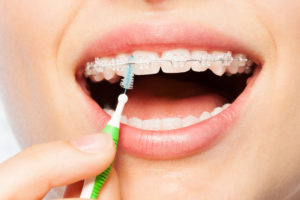
While similar to managing our oral health, maintaining our braces has a few extra steps. To maintain good oral health with braces, it’s important to adopt good oral hygiene throughout the entire process. Brushing after every meal is one of the most important but most overlooked steps in maintaining good oral health. When eating, food particles get stuck in between our teeth and our braces, which can cause staining and bacterial backup between our teeth. Using a regular soft brush in an up-and-down motion on each tooth will do the trick. Secondly, use threadable floss or a floss threader. These tools allow you to get between each tooth and underneath the wires to clean out any food that may be trapped there. Insert the threader between two teeth and move back and forth until the food is released. Lastly, use a proxabrush, or a “Christmas tree brush.” Place the proxabrush between two brackets, below the archwire, and brush up and down. Like the threader, this will also help loosen up any food that may be stuck between your teeth.
A great way to ensure that your braces don’t break and that you don’t get unwanted gunk stuck in them is to watch what foods you’re eating. Foods that are hard, sticky, or high in sugar should be avoided. Eating food that is high in sugar can cause cavities when wearing braces, which can lead to more dental work that you would need to have done. Furthermore, patients with braces should limit between meal snacks and avoid food that could bend the wires, such as caramel, nuts, chewing gum, ice, or popcorn.
When To See An Orthodontist
Now that we understand more about the importance of our oral health, plus the different types of braces, when should we make an appointment with an orthodontist? Many times, we only schedule a time to see an orthodontist whenever our teeth are crooked and we want them straightened. But there are other factors that influence when we should start thinking about getting in to see the doctor:
- Jaws that shift, make sounds, protrude, or are recessed
- Speech difficulty
- Biting the cheek or biting into the roof of the mouth
- Facial imbalance or asymmetry (features out of proportion to the rest of the face)
- Inability to comfortably close lips
- Grinding or clenching of teeth
As mentioned earlier, these are signs that your oral health might not be up to par like it should be. Meeting with your orthodontist and discussing these issues will help them better treat you with one of the four types of braces that we discussed previously. The sooner you get in to see your orthodontist, the sooner any pain or discomfort can be evaluated, treated, and extinguished.
Meet Your New Year’s Resolutions With Our Help!
Belmar Orthodontics can help you on your path towards having a straighter smiles and better oral health. With reputable orthodontists, manageable treatment plans, and services for children and adults, we can help you get the smile that you deserve! Call (303) 225-9016!
Braces: How Are They Made?
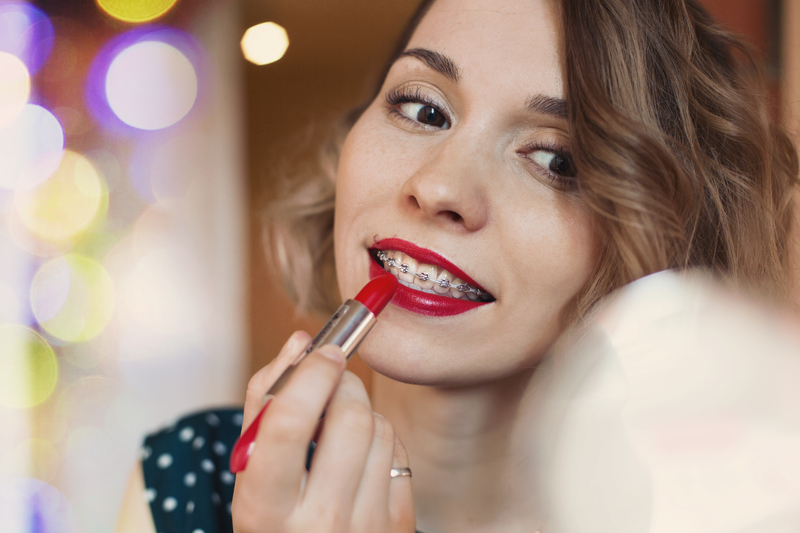
You may wonder what the differences are between metal, ceramic, and lingual braces and how they compare to Invisalign treatment. All are a bit different and they are both made and worn differently. Braces are made from various materials and designed specifically for your mouth.
Metal Braces and Your Teeth
You’ve likely seen someone wearing metal braces and you know that they make your teeth straighter. But how? It takes a bit of science and the right orthodontic appliance to make that beautiful smile happen. With the most common type of braces—metal braces—you have a stainless steel material that is shaped into specific orthodontic parts that will all go together in your mouth. Often those parts are molded and shaped in a special lab that then ships those parts to orthodontists.
Labs will even do custom-made brackets and wires for patients when the need arises. However, most braces have a specific design like metal braces do. Metal braces have several parts that include:
- Brackets: These stainless steel pieces are those little squares bonded to the middle of each tooth. We use a special bonding glue that will stay on your teeth for the entire duration of your treatment, but will come off easily with the right orthodontic material. Your brackets are small anchors that hold a wire in place. They will have tiny rubber elastics placed around them to protect your teeth and prevent stuck food.
- Archwire: This metal wire will pass through the brackets on each tooth, all the way to the back of your mouth. Many patients have a bracket that wraps around the back molar that stabilizes this archwire. The wire will follow the curve of your jaws in an elongated have circle. When a thicker archwire is placed or when this archwire is adjusted, it can help move the teeth into place because of the force placed on the brackets.
- Ligature Elastics: These are the rubber elastics we mentioned. The elastics are what keep the archwire sturdy so it can straighten your teeth.
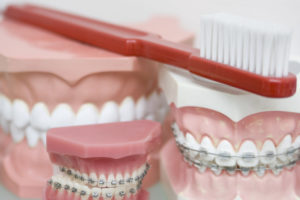
How Teeth Straighten
Your archwire will be adjusted very slightly at your orthodontic appointments every 4-6 weeks. That slight adjustment may seem very small, but it’s what your mouth needs to make a true, straightening change. The appliance is not the only thing changing your teeth into a straighter position. Your teeth are the hardest substance in the body and can even be harder than many metals. Straightening them would seem very difficult, when it’s not. It simply takes time.
Your teeth can take a ton of force from chewing, biting, eating, talking and other actions because they are rooted into your jawbone. However, the jawbone is much weaker than the teeth are. So why doesn’t your jawbone get breaks in it when you chew hard things? You have something called the periodontic ligament that is around every tooth root as it goes into your jaw bone. All those ligaments are shock absorbers for your jaws when you chew, minimizing the force your jawbones take. These are key to straightening the teeth.
When orthodontic appliances are on the teeth, they will apply a very slight pressure to your teeth and to the periodontic ligaments that surround them. When that pressure is constantly there, your body will produce acids in the jawbone area that will break down tiny parts around the teeth. With new space created, the teeth can shift. Your body will naturally deposit more minerals in areas that have changed to strengthen the jawbone once more. Over time, your jaw is literally breaking itself down on a microscopic level and then rebuilding itself. That is why orthodontic treatment takes months. However, the result is worth it.
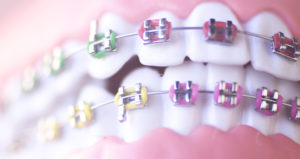
Ceramic and Lingual Braces
Ceramic and lingual braces are very similar to traditional metal braces, but are made a bit differently. Lingual braces are also a metal braces type, and most types are made from stainless steel in a lab. There can be other types of metal used or a combination of metals. These braces will have brackets and wires just like traditional metal braces, except that they will be placed on the back of a patient’s teeth.
Because of placement, children are not usually candidates for lingual braces because of the size of the teeth. Dental impressions of the back of the teeth are made so that metal coverings can be made for the tooth backs, which is a bit different than traditional metal braces. More anchoring is needed with lingual braces, and this is how it is done. The metal material will cover the entire tooth back with a bracket in the center of the tooth, and each is placed individually when a patient gets their appliance. The archwire works the same as other braces.
Ceramic braces are very similar to metal braces in their design and how they work. However, they are made from ceramic material, which is naturally white already. This makes the braces blend in with the teeth more, and the metal can even be frosted to blend in with whiter teeth.
Invisalign: Customized to the Patient
Invisalign treatment is an orthodontic option that is vastly different than your other options. The most noticeable difference is that there is no metal or ceramic material in your appliance. A patient will have digital images taken of their mouth. With that image, custom aligners are made that a patient will switch out each week. These are a type of plastic material patented by the Invisalign company. It’s a strong enough plastic to cause the same type of shifting you want your teeth to do. Aligners fit snug in the mouth as they are custom made, are switched out each week, and must be worn 20-22 hours of the day. If you are interested in any of these types of braces or want to see how the braces are put on a patient, call Belmar Orthodontics today at (303) 225-9016 with your questions!
Change Your Smile in 2019

Millions are ready to make changes in their life with the start of a new year. If you haven’t already, consider adding resolutions to transform your smile in 2019. This is quite easy to do if you have the right tips to get started. Whether you want a whiter smile, straighter smile or you want to change your oral health issues, you can achieve it.
Resolutions 2019
Making New Year’s resolutions is something that countless millions will do in the month of December. For many, the start of a new year is a time for reevaluating health and life goals, and a time when many recommit to goals they didn’t quite reach. Some of the top resolutions include:
- Eating healthier
- Exercising more
- Smiling more
- Saving money
- Making better health choices
- Sleeping enough
- Being social
Did you notice that oral health isn’t anywhere on the top resolutions that people make? Oral health is often overlooked because it seems like something so small compared to your overall health. However, your oral health is directly related to how healthy you are. Improvements to your smile and mouth health can improve your health and wellness.
Many chronic conditions become worse if your oral hygiene is lacking. Some include diabetes, heart disease, autoimmune disorders, and anything that has to due with your nutrition. With chronic oral health problems such as extensive tooth loss, your overall health will decline rapidly. You may not be able to eat, and chewing, biting, smiling and other basic functions will become difficult. However, most oral health issues are avoidable by simple habits done daily. You have heard of most of these habits already, as they are the basics you hear from the dentist every time you go in for a visit. However, most people can improve their technique with oral hygiene even if they are already doing the basics.

Small Changes, Big Results
Our patients either have braces on their teeth or they are looking to get them. Great oral health is needed if you want to get braces on your teeth. We make sure that our patients are free of cavities and gum issues before orthodontic treatment happens. That means, a dental visit is needed to check for any dental issues beforehand. When dental issues are there, they are fixed and great oral hygiene must be followed thereafter. That includes:
- Brushing. Brush your teeth at least twice a day with fluoride toothpaste. With braces, brush after every meal. Use a proxabrush tool or a Waterpik to dislodge stuck food. Brush in all different directions, especially with the brackets. Replace your toothbrush every 3 months or when the bristles become frayed.
- Flossing. This step is skipped often, but is so important to your smile! Flossing gets 40% of your tooth surfaces. If you want a better smile with braces, you gotta floss or that smile will be damaged. Whether you have braces or are getting them, make the decision to floss 1-2 times every day, using floss threaders or threadable floss.
- Nutrition: Skip the sugary foods as much as possible. This leads to plaque production and tooth decay. Avoid carbonated drinks or ones with citrus that leads to tooth erosion.
Continuous Oral Problems
If you brush, floss, visit the dentist and use oral health aids like mouthwash and fluoride, you may wonder why you still get cavities and gum problems. Studies show that your smile and oral health can be determined by genetics in some cases. Some genes that run in families or specific cultures can make you more susceptible to oral health diseases. For example, those of African descent have specific genes that make them more susceptible to gum disease.
If you have specific conditions that run in your family such as heart disease or diabetes, oral health problems will likely follow suit. This is not inevitable, but something you must be aware of. If you have any sort of chronic condition, make sure you are doing all that you can to have good oral hygiene habits throughout your day. If you continue to have frequent oral problems or issues with your smile, we can go over proper oral hygiene methods during one of your orthodontic appointments. Great oral hygiene and following proper techniques is very important to keeping your teeth healthy and strong, especially with braces. Sometimes, all it takes is changing up your technique or what you are eating to have better oral health and a better smile.
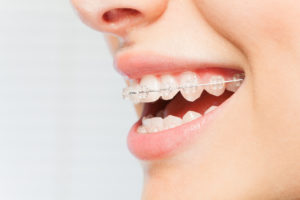
Cosmetic Changes to Your Smile
If you want to completely transform your smile in 2019, don’t wait to get orthodontic treatment. Studies show that getting braces is a great way to not only help you reduce your oral health problems, but an excellent way to get a better smile. Orthodontic treatment generally takes 18 months or less from start to finish. Some patients only need braces for 6 months depending on their teeth and what treatment option they choose.
There are many orthodontic options patients have to transform their smile, and half of them are invisible options. That means, you can’t see the appliances on your teeth. You have the options of:
- Traditional Metal Braces – These are the classic metal bracket and wire option that is most commonly chosen by patients.
- Ceramic Braces – These have the same bracket and wire design of metal braces, except that they are made out of white ceramic material. This helps decrease demineralization during your orthodontic treatment.
- Lingual Braces – This is a discrete metal braces option that is placed on the back of your teeth. Instead of just a square bracket, the metal must be custom-made to the shape of the back of your teeth.
- Invisalign Treatment – This is the most invisible option available to our patients. Invisalign is a series of transparent aligners that you wear at night and throughout the day. You can remove them for eating, playing sports, cleaning your teeth and more.
To choose your option today, call Belmar Orthodontics at (303) 225-9016!
Dressing Up Your Smile During the Holidays

The holidays are here, which means parties, dinners, photo opportunities and more. Now is a great time to make your smile shine, and you can do that through orthodontic treatment. If you’re smile is lack-luster, consider our four orthodontic options that can help you have a straighter smile. For those already with braces, you can dress up your brackets with bright colors to reflect the season. Use these tips for getting a more beautiful smile with braces and having that show in your holiday snapshots this year!
Dress Up Your Smile with Orthodontics
The higher number of holidays during the winter season is believed to be because of the many pagan festivals that surrounded the Winter Solstice many years ago. That solstice happens in the third week of december, where there is Christmas, Hanukkah, New Years and other holidays all happening. With all those holidays and the gatherings that come with them, it’s likely to mean many opportunities for photos and showing off your smile. You want that smile to impress.
Studies show that people that straighten their smiles often feel more confident than those who don’t. That confidence can be visible even while you are currently getting orthodontic treatment. Straight teeth are so important to people that 87% of people are willing to forego something they want for a year or more to be able to get braces. If you have braces, not only is it something to be proud of, but something to be admired. If you don’t have braces, getting them is a great way to give yourself an amazing gift just in time for the holidays.

Your Treatment Options
In the past, metal braces were your only option. However, you have many cool options today that you can gift yourself such as:
- Traditional Metal Braces – These are the classic metal bracket and wire option that is most commonly chosen by patients. Patients who chose this option come in to have their wires tightened at each appointment.
- Ceramic Braces – These braces are a close cousin to metal braces. They have the same bracket and wire design of metal braces, except that they are made out of ceramic material. This helps decrease demineralization during your orthodontic treatment. Ceramic material is also naturally white, helping these braces to blend in with your teeth more than metal would.
- Lingual Braces – These are metal braces that are placed on the back of your teeth. Instead of just a square bracket, the metal must be custom-made to the shape of the back of your teeth. This is a discrete option that adults and teens love.
- Invisalign Treatment – This is the most invisible option available to our patients. Invisalign is a series of transparent aligners that you wear at night and throughout the day. You can remove them for eating, playing sports, cleaning your teeth and more.
If You Already Have Braces
Maybe you already have braces. You can still make your smile wow in pictures by taking care of your smile. If you have metal or ceramic braces, our patients love to get colored bands that reflect the colors of the holidays. You can make your bands green and red for Christmas, blue and white for winter or any color you would like. Colorful bracket bands are just one way you can dress up your smile.
If you already have braces, then you have already started on your journey to a better smile. Orthodontic treatment can correct mild to severe issues with bite and alignment, and can help correct speech impediments. It can bring the teeth and jaws into proper position, reducing your risk for oral health diseases such as tooth decay and gum disease. Straighter teeth are teeth that are easier to clean and less likely to have breaks and fractures from uneven mouth pressure.
However, if you want your smile to dazzle in photos and at holiday get-togethers, you have to take care of it. The best way to do that is by brushing and flossing your teeth. Those two simple steps should be dones several times a day to keep your brackets clean and your teeth polished. Patients should brush 3 times a day or more to dislodge food and to clean the teeth after meals. Flossing should be done 1-2 times a day. Even though it takes a bit longer to do, don’t skip this step! If you do, you miss cleaning 40% of your tooth surfaces that can leave them open to decay, erosion and staining. Those are not things you want in a holiday photo.

Better Health for the New Year
The end of the year is a time to start making goals for the new year. One of those goals can be focused around having better health in the new year. Many people don’t realize just how connected oral health is with overall health. Countless chronic conditions can become more mild or they can intensify depending on how well you are taking care of your oral health. For example, if you have diabetes, not taking care of your teeth and gums can lead to oral infections that are really hard to battle because you have diabetes. Your body is less able to fight those infections and the infections can spread, worsening your condition.
However, if you do the basics of brushing your teeth, flossing and visiting your dentist and orthodontist like you should, you can keep your oral health in great shape. That makes it so your smile is amazing when your braces come off instead of damaged or decayed. To get some tips for taking care of your braces or for starting on an orthodontic plan, call Belmar Orthodontics today at (303) 225-9016!
Be Thankful for Orthodontic Treatment

Studies show that not enough Americans are taking good care of their teeth, especially through dental and orthodontic treatment. The advanced technology available today is what allows patients to keep their natural teeth healthy for life and is something that millions in the world don’t have access to. Find out why oral health services such as orthodontic treatment is so important to patients and something to be thankful for this time of year!
Your Oral Health
When you think of the most chronic conditions and diseases that plague people today, you may not think of cavities as being one of the them. The National Institutes of Health reports that tooth decay—or cavities—are the most “chronic, prevalent disease” among American children and adults. In fact, about 92% of people have tooth decay by the time they reach adulthood. In all age groups, roughly between 20% and 25% of people have untreated decay they are not aware of.
What does tooth decay have to do with orthodontic treatment? This decay can happen to anyone at anytime and you are more likely to have tooth decay during your orthodontic treatment. Many patients opt for lingual, ceramic or traditional metal braces to straighten their teeth. These methods require brackets that are bonded to the teeth with wires that pass through those brackets. Even though these appliances are highly effective for providing beautiful straightening power, they can make it harder to clean your teeth. Because it’s harder to clean them, and some patients don’t take the extra time to do this, you can end up with tooth decay. That adds to that 92% statistic.
The best way to eliminate your risk for that tooth decay (as well as other oral health diseases), is to properly care for your teeth both with and without braces. That involves brushing your teeth at least twice a day for 2 minutes at a time, as recommended by the American Dental Association. When you have braces, you have to do this after every meal to avoid acidic plaque buildup, which happens when your food and drink sugars mix with mouth bacteria. With braces, threadable floss to go around brackets and wires is generally needed, as well as cleaning items such as a waterpik (water shooter) tool and a proxabrush for brackets. Your oral health can be stellar during orthodontic treatment with the right oral hygiene.

How Does the U.S. Compare?
Orthodontic treatment is a time when those in the U.S. can have a greater risk for developing cavities. This comes from a lack of oral hygiene during your orthodontic treatment period. However, the world at large is battling oral health diseases and poor dental and orthodontic care on an epidemic scale. The World Health Organization reports that cavities (tooth decay) and gum disease (periodontal disease) “have historically been considered the most important global oral health burdens”.
60%-90% of people worldwide have tooth decay and oral diseases connected to this condition. Children are affected the most, but statistics are almost as high in adults worldwide. Even though the U.S. is at a high percentage when it comes to tooth decay (92%), the presence of tooth decay is generally eliminated in most of the population through proper dental work and access to dental services. In the majority of other countries—especially underdeveloped ones—dental or orthodontic work is not a possibility for most. Oral health diseases are simply left untreated or the teeth are pulled when they become too painful.
The Connection to Orthodontic Treatment
Getting a cavity or having an oral health problem during your life can definitely be avoided, but most people will have some sort of oral problem, even if it is small. There are ways to prevent those problems such as proper brushing and flossing every single day. A great way to reduce your risk for oral health diseases is through orthodontic treatment. For children, this is known as child orthodontics. The American Association of Orthodontics recommends that children have their first orthodontic appointment between age 7 or 8.
This is a time when baby teeth are starting to fall out and adult, permanent teeth are starting to come into the mouth. Proper examination by an orthodontist can sport bite and alignment issues that are developing in children. When these issues occur, the teeth can come in crooked all over or they may not rest in the position they are supposed to. This can lead to speech impediments, many dental emergencies and broken teeth in the future from uneven dental pressure, higher instances of tooth decay and gum disease, and problems with oral health diseases.
Orthodontic treatment when young can help align the teeth and jaws to prevent oral problems as a child grows. When teens and adults receive orthodontic treatment via braces, they can better straighten permanent teeth when they come in. This sets everything straight and functional before the jaws harden in adulthood. Straight teeth and aligned jaws make it so cleaning the teeth becomes almost effortless. The risk for tooth decay and gum disease is also significantly lower.

Be Thankful for Your Orthodontic Treatment
Dentistry and orthodontic treatment helps diminish the presence of oral diseases.Yes, tooth decay and gum disease happen frequently due to poor oral hygiene habits. However, orthodontic treatment can help prevent those problems in the first place. Great oral care can prevent developing problems throughout your life. Even when these issues do happen, you won’t have to simply get your teeth pulled or let them decay and fall out of your mouth.
You have great orthodontic and dental options in the United States that allow you to keep your teeth, while many people across the globe have to lose them. Remember that the next time you think about skipping your oral care appointments. To reduce your risk for oral health diseases, you can call Belmar Orthodontics at (303) 225-9016 and ask about your orthodontic treatment plan.
Adjusting to Lingual Braces

There are four main types of braces that include traditional metal braces, ceramic braces, lingual and Invisalign treatment. When patients want sturdy metal for effective straightening power, but they don’t want visible metal, lingual braces is the option to choose. This consists of an orthodontic appliance attached to the back of the teeth. With any orthodontic appliance attached to the teeth, there will be an adjustment period for patients.
Why Get Braces?
Many people wonder why they would need orthodontic treatment if they are already seeing a dentist. However, a dentist is not the same as an orthodontist. Both have gone to dental school, but only an orthodontist can correct bite and alignment issues that would cause oral health diseases, problems with speech and issues with eating. Straighter teeth are teeth that are easier to clean, helping you avoid oral health diseases.
The teeth are less likely to crack, chip, fracture or break from uneven biting pressure when they are straighter. Studies show that people who straighten their teeth often feel more attractive, confident and motivated, and others view them that way as well. Braces can not only help reduce your risk of oral health problems (or help them to go away), but they can make you feel like a million bucks from the beautiful smile you receive.
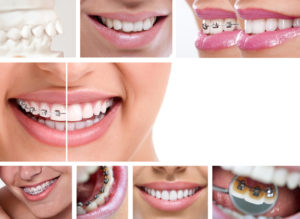
What Are Your Options?
In the past, traditional metal braces were the only braces option patients could get. Today, there are four main orthodontic options. Those include:
- Traditional Metal Braces – These are the classic metal bracket and wire option that is most commonly chosen by patients. Patients who chose this option come in to have their wires tightened at each appointment.
- Ceramic Braces – These braces are a close cousin to metal braces. They have the same bracket and wire design of metal braces, except that they are made out of ceramic material. This helps decrease demineralization during your orthodontic treatment. Ceramic material is also naturally white, helping these braces to blend in with your teeth more than metal would.
- Lingual Braces – These are metal braces that are placed on the back of your teeth. Instead of just a square bracket, the metal must be custom-made to the shape of the back of your teeth. This is a discrete option that adults and teens love.
- Invisalign Treatment – This is the most invisible option available to our patients. Invisalign is a series of transparent aligners that you wear at night and throughout the day. You can remove them for eating, playing sports, cleaning your teeth and more.
Adjusting to Lingual Braces and More
For many patients, the adjustment period with their orthodontic appliance will be a new experience. Getting braces on the teeth is a new and exciting chapter for anyone that is starting on their journey to a better smile. However, your mouth does have to physically adjust to orthodontic appliances. With traditional metal, ceramic, or lingual braces, there are orthodontic parts that will be bonded to the teeth with a cement-like bonding material.
The application of that bonding material with your teeth will place extra pressure on them for several days. You may have to take an over-the-counter painkiller (like Tylenol) to help ease that aching feeling. Soft foods like yogurt or pasta will be better after the braces application for sensitive teeth. Your tongue will have to adjust to orthodontic appliances as well. For traditional metal braces on the front of your teeth, they may feel bulky as they rest against your lips.
With lingual braces, your tongue may feel more crowded or may constantly run into the brackets. With both of these options, a patient’s mouth becomes used to the appliances so quickly that they won’t even notice the braces after a few days. Your smile won’t look bulky with your appliance, but it will start to look straighter over time. Cleaning your teeth will take a bit more work, but this too will become second nature to you. With each new braces adjustment, your teeth may feel a bit sore, but that feeling will go away quickly.

Keeping Your Smile Healthy
You can spend 18 or more months straightening your teeth, only to have them be decayed at the end of your treatment. However, this doesn’t have to happen if you are taking meticulous care of your teeth with braces on them. Patients should be brushing and flossing their teeth whether or not they have braces on them. The American Dental Association recommends that every person brush their teeth at least twice a day. With braces, you want to brush them very well after every meal to dislodge food that would cause decay.
Flossing is key as well, as flossing gets about 40% of your tooth surfaces that brushing misses. If you skip flossing all the time, all those tooth surfaces can decay. With braces, you won’t be able to do the normal flossing you’re used to. Lingual braces can be even harder if you can’t see where you are flossing. This is where flossing tools for braces come in handy. Invest in threadable floss or flossers (which is very similar). This is floss that you stick through the cracks in your teeth and pull through like a sewing needle. You floss the tooth, scraping the teeth as you go, and pull the floss all the way through the tooth to start on a new one. It only takes a minute or so more than normal flossing, but will help prevent decay with your lingual braces.
Braces Are an Investment
Your teeth may take a bit more time to keep clean with braces on them than they were before. However, with braces such as lingual braces, you’re making your smile straighter and more beautiful for years to come. That straightness will not only help make cleaning the teeth easier for years, but it will help your appearance and your confidence. If you want all the benefits of a beautiful, straight smile, call Belmar Orthodontics today at (303) 225-9016!
Braces Can Change Your Life
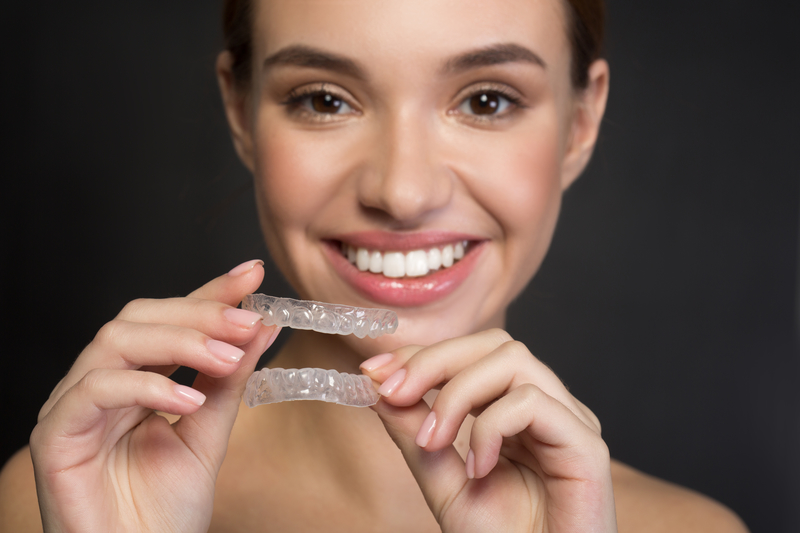
Your oral health can determine much of your overall health. Food and substances enter through your mouth, affecting your waistline, your appearance and your health. Your oral health can improve your overall health when you make changes in oral hygiene and bite and alignment. Misalignments in bites and crooked teeth can cause health and social problems, as they can lead to speech impediments, oral health diseases, and worsening chronic conditions. With braces, you can not only change how healthy your mouth is, but can change your life too!
Growing In Straight Teeth
Many people picture teens when they think of braces. However, 1/4th of people with braces are kids. Child orthodontics help straighten out teeth that would cause them speech problems, broken teeth and trouble growing in the permanent teeth. Adults and teens usually get them for crooked teeth.
However, braces aren’t just for people with crooked teeth. You may see patients young and old that appear to have a straight smile and yet they have to get braces. In this case, there is probably an oral health issue with the bite or alignment. Your teeth should line up along both the upper jaw and the lower jaw. When you go to the dentist, they will ask you to bite together so that they can view how your bite rests. How your teeth sit when they are resting together can determine if you will have dental issues and even speech impediments. This is especially true for young kids who are losing baby teeth and having adult teeth grow in.
Children have their baby teeth for years—even up to age 12 or later at times. Those baby teeth start to space out a bit more as a child grows from an infant to a school-aged child. Their mouth grows with them, making room for adult teeth. 20 baby teeth will become 32 adult teeth (including the wisdom teeth). However, those teeth don’t always come into the mouth in the right position or the right direction. With a healthy bite, the upper and lower jaws should have the teeth lining up evenly with one another. The teeth should be straight up and down, and the front upper teeth will rest just slightly in front of the bottom front teeth.
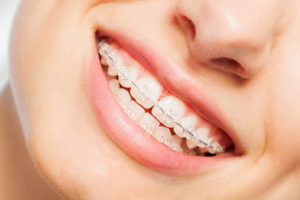
Braces Can Prevent Dental Injuries
When teeth aren’t straight and they jut out at different angles, it can mean broken, cracked or chipped teeth in the future. Those dental injuries would be caused by uneven pressure on certain teeth which will eventually break them or will cause areas of decay that you can’t clean well. The alignment of the teeth can also cause speech impediments when forming words, and those impediments can last for life if bite, alignment and crooked teeth aren’t corrected. For young children and adults alike, receiving braces for these issues can certainly change not only their oral health, but their life.
Braces are sometimes needed to make space in a patient’s mouth. Not all mouths grow to fit the incoming teeth, but that doesn’t mean the adult teeth won’t stop coming in. All your teeth will come in, even if they have to crowd out other teeth. That crowding can be painful and even one tooth coming in where there isn’t room can cause all of your teeth to go crooked. As a tooth comes in, it will slowly push other teeth from the area, which then have to shift. This is what wisdom teeth commonly do, and it can be painful as it messes up a smile. Braces can stop that from happening by making plenty of space in the mouth for teeth that are still coming in.
What If You Have Your Teeth Already?
The dental issues we have mentioned will generally happen before a person has reached adulthood. The American Association of Orthodontics recommends that children have their first orthodontic appointment around age 7 or 8. This is when we can see how the baby teeth are falling out and how the permanent teeth are coming in. We stop dental issues before they start forming, and during this time when the jaw bones are still soft enough to mold. However, at least 1/4th of patients that have braces get them when they are adults. The jaws have grow completely and have hardened into place by adulthood, making orthodontic treatment harder.
However, we said “harder”, not “impossible”. Orthodontic advancements can definitely help an adult change their smile to change their life. Now, more than ever, it is becoming increasingly important to have a straight smile as an adult. Studies show that others make an opinion of you based off of the first few seconds of meeting you. Your appearance can go a long way. Your smile is also one of the top 3 features others will notice first when formulating an opinion about you. Studies show that those with straighter teeth are seen as more attractive, successful, smart, healthy and trustworthy. Employers are more likely to hire those with straight smiles over those who don’t have them.

Your Options
If you’re an adult, you can straighten your smile without it being noticeable. Children often go the route of traditional metal braces or ceramic braces, which are the same but made from ceramic material. Adults and many teens opt for hidden options like lingual braces or Invisalign treatment. Lingual braces are metal braces that attach behind the teeth, staying hidden as they correct bite, alignment and your teeth. Invisalign treatment consists of transparent aligners patients change out every week. However, they don’t do as well with larger bite and alignment issues. It’s never too late to receive orthodontic treatment.
Whether you are young or old, you can change your smile to reduce or eliminate your problems with speech, tooth decay, oral health issues, dental injuries and to even feel more attractive. Want to see just how much braces can change your life? Call Belmar Orthodontics today at (303) 225-9016 to receive your free consultation!
Lingual Braces: History and Benefits

Several decades ago, traditional metal braces were the only option available for patients to get a beautiful, straight smile. However, the traditional take on braces changed when lingual braces were introduced. These are metal braces that go in your mouth, except they are bonded to the back of your teeth instead of the front. This option is a popular one for teens and adults, as they can hide their metal braces in their mouth as they straighten the teeth.
What Are Traditional Metal Braces?
Metal braces are “traditional” because the bracket-and-wire design they have has been used for decades. Before 1970, orthodontists anchored metal brackets to the center of each tooth and wound wires around the teeth to straighten them. After 1970, orthodontists continued to use metal anchorage devices (called brackets) on the front and center of each tooth.
A metal archwire was sufficient for straightening when it ran along the upper and lower jaws across the front of the teeth. Traditional braces use a system of archwires and brackets that are bonded to the teeth to shift them into their ideal position. When we see you at your frequent checkups, we will adjust the archwire, which will exert more pressure on your teeth, moving them in place.
The back molars will have metal bands that fit all the way around the back molars of the teeth. This is where the archwire will attach and be stabilized. Both top and bottom jaws will have these bands on them. The brackets on each tooth will have a rubber band around them, which are removable. They help keep your bracket hooks from catching on your mouth.
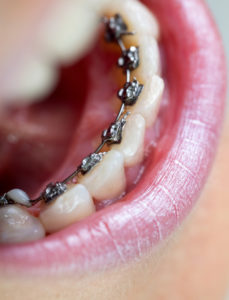
How Are Lingual Braces Different?
Lingual braces are similar to traditional metal braces. Many people don’t aesthetically like the look of metal braces, but they love their final straight smile. Metal braces are the strongest and are highly effective for achieving a beautiful smile. What can patients do if they want a straight smile but they don’t want braces front and center? Put that metal on the inside of the mouth between the teeth and the tongue!
Lingual braces are metal braces just like the traditional version, except that they are on the tongue-side of your teeth. However, there isn’t as much room on the back of your teeth like there is on the front of your teeth. If you notice, there is also a bit of a curve to the back of some of your teeth. That bracket-and-wire design can’t be exactly like the traditional version, but the design can be similar.
Using the same idea as traditional metal braces, you can achieve the same results as traditional braces, only with a hidden treatment apparatus on the tongue-side of your teeth. Patients that choose this option have impressions made of their mouth that focus on the backs of their teeth. After those impressions are sent to a special lab, metal backings for the teeth are made that are then bonded to the back of your teeth. They are almost like metal coverings for the entire tooth back, and often are silver or gold in color. These metal coverings also have small metal brackets and wires that discreetly correct bite and alignment issues over time. The concept is similar, but the design is tweaked to give lingual braces the same stability as traditional metal ones.
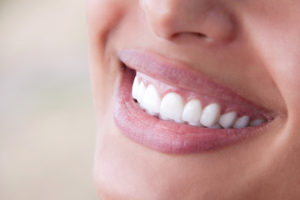
The Invention of Lingual Braces
- The push for hidden braces first started in the 70s with celebrities and public figures that wanted straighter teeth without visible metal braces.
- Craven Kurz and Jim Mulick were the first to develop prototypes for these braces in 1975. Craven Kurz was an orthodontist who later founded the American Lingual Orthodontic Association. Jim Mulick was the man Kurz partnered with from the UCLA School of Dentistry.
- The first prototypes of lingual braces led to tongue irritation and bracket breaks, which were resolved by inventing an inclined plane for these braces.
- Lingual braces are usually made of stainless steel, but they can also be made out of titanium.
- Craven Kurz applied for a patent in 1976 and the first lingual braces were produced in 1979. Ormco was the company Kurz partnered with that eventually created 7 different generations of lingual models until the current model.
- Each model involved changes to the orthodontic appliance including the additions of hooks and crannies, anterior and molar brackets and hooks, inclined planes, torque values, transpalatal bar hooks and a heart-shaped inclined plane.
- There are various designs of lingual braces that will vary based on how they look and how they are attached to the teeth. We use the “Incognito” style, but you may also hear types such as “iBraces”, “In-Ovation”, “STb Light Lingual System” and “Suresmile Lingual QT”.
How Do You Benefit?
Getting braces at all is a major step in the right direction if you want to be successful. Studies show that people who straighten their teeth often feel more confident in themselves, and their actions become more confident. Due to social, economic or aesthetic concerns, many patients may have the desire to straighten their teeth, but they don’t want to have metal braces on their teeth. For adults with careers or active social lives, they may view traditional metal braces as something only children and teens have.
However, at least 1/4th of patients with braces are adults. You simply may not see those braces because they have invisible braces like lingual braces. Lingual braces can achieve the same effect as regular metal braces without being seen. For a career setting, you can keep your white smile as it slowly becomes straighter overtime. For athletes, there isn’t a worry about dental injuries, as brackets and wires won’t cut up the cheeks or gums. Those who play wind instruments will find that lingual braces are much easier to play with than traditional braces. You get both the aesthetic appeal with sturdy straightening power with lingual braces. If you would like your free consultation, call Belmar Orthodontics today at (303) 225-9016!

